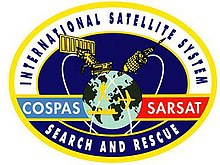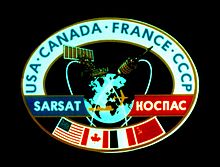
Back Cospas-Sarsat Czech COSPAS-SARSAT German Cospas-Sarsat Spanish کوسپاس-سارست Persian COSPAS-SARSAT Finnish Cospas-Sarsat French Cospas-Sarsat HE Koszpasz-Sarsat Hungarian Cospas-Sarsat ID Alþjóðlega Cospas-Sarsat-verkefnið Icelandic
 | |
| Established | 1 July 1988 (Date definitive agreement was signed; preceding memorandums of understanding signed 23 November 1979 and 5 October 1984) |
|---|---|
| Type | Intergovernmental organization |
| Legal status | Active |
| Headquarters | Montreal, Quebec, Canada |
| Membership | 45 Formally associated "Participant" states and agencies
|
Official languages | English French Russian |
Head | Shefali Juneja (Head of Secretariat) |
Council Chair (rotating) | Henrik Smith (Canada) |
| Website | www www |

The International Cospas-Sarsat Programme is a satellite-aided search and rescue (SAR) initiative. It is organized as a treaty-based, nonprofit, intergovernmental, humanitarian cooperative of 45 nations and agencies (see infobox).[2] It is dedicated to detecting and locating emergency locator radio beacons activated by persons, aircraft or vessels in distress, and forwarding this alert information to authorities that can take action for rescue.[3][4][5] Member countries support the distribution of distress alerts using a constellation of around 65 satellites orbiting the Earth which carry transponders and signal processors capable of locating an emergency beacon anywhere on Earth transmitting on the Cospas-Sarsat frequency of 406 MHz.
Distress alerts are detected, located and forwarded to over 200 countries and territories at no cost to beacon owners or the receiving government agencies.[6] Cospas-Sarsat was conceived and initiated by Canada, France, the United States, and the former Soviet Union in 1979.[7] The first rescue using the technology of Cospas-Sarsat occurred on 10 September 1982.[8][9] The definitive agreement of the organization was signed by those four States as the "Parties" to the agreement on 1 July 1988.
The term Cospas-Sarsat derives from COSPAS (КОСПАС), an acronym from the transliterated Russian "Космическая Система Поиска Аварийных Судов" (Latin script: "Cosmicheskaya Sistema Poiska Avariynyh Sudov"), meaning "Space System for the Search of Vessels in Distress", and SARSAT, an acronym for "Search And Rescue Satellite-Aided Tracking".[10]
- ^ Galileo's Contribution to Cospas-Sarsat
- ^ Cospas-Sarsat website, Formally associated Participant states and agencies
- ^ International Cospas-Sarsat Programme Agreement – UN Treaty Series (PDF)
- ^ Cospas-Sarsat website, "International Cospas-Sarsat Programme Agreement" (PDF)
- ^ "Strategic Goals for the Cospas-Sarsat Programme", Cospas-Sarsat Strategic Plan (PDF), Cospas-Sarsat
- ^ Cospas-Sarsat website, "What is a Cospas-Sarsat 406 MHz Beacon"
- ^ Space Foundation's Space Technology Hall of Fame inducted technology
- ^ The Washington Post, 30 September 1982, page A3
- ^ The Hartford Courant, 25 November 1982, page A6
- ^ "About the Programme - International COSPAS-SARSAT". www.cospas-sarsat.int. Retrieved 2022-12-21.